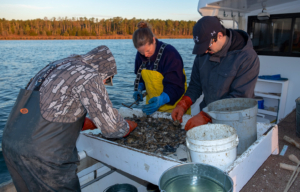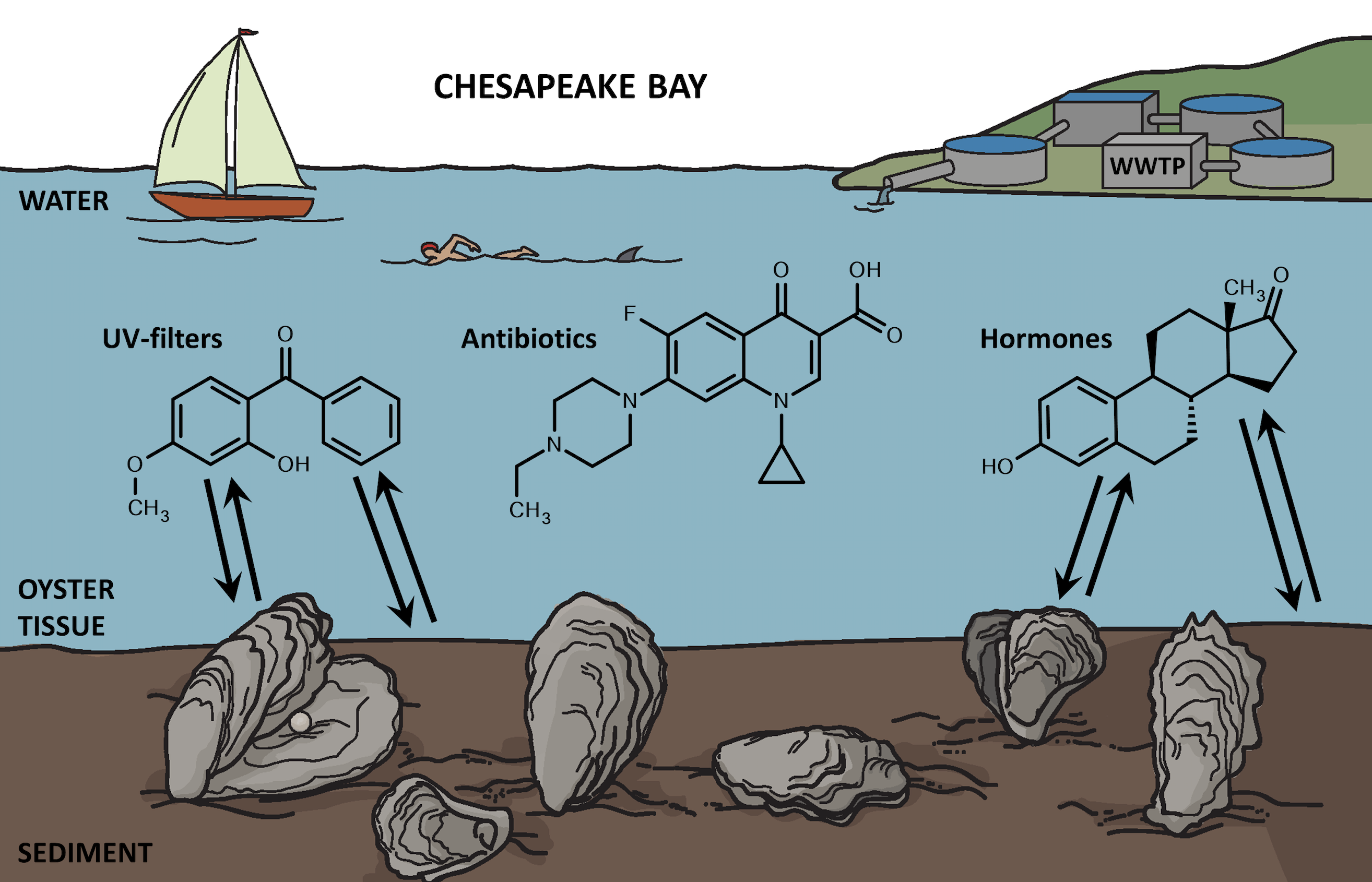UMBC Researcher Leads Landmark Study on Contaminants in the Chesapeake
While many studies have looked at particular contaminants of emerging concern in local rivers and small watersheds, few researchers have looked at multiple contaminants in the larger Chesapeake Bay watershed. Dr. Lee Blaney of the University of Maryland Baltimore County (UMBC) led a team of researchers in quantifying concentrations of antibiotics, estrogenic hormones, and UV-filters in numerous locations around the Chesapeake Bay.
Previous studies completed throughout the early 2000s concentrated on contaminants in terrestrial streams, looking at hormones or antibiotics separately. They studied one particular river system at a time, focusing on areas near wastewater treatment plants and animal feeding operations.
But the Chesapeake Bay is a lot more complicated – tides cause mixing, and many believed that contaminants would be diluted to low concentrations. But Blaney wanted to know for sure: “we wanted to analyze samples from places where contaminants of emerging concern were not expected to be present at high concentrations or frequencies.”
Executing a study of this size
In order to get samples from across the Bay watershed, Blaney’s team worked with Maryland Department of Natural Resources and Maryland Department of Environment to collect water, sediment, and oyster tissue. Their recent paper focuses on the first set of samples from summer 2016 and spring 2017, but every fall since 2017, the team has visited 50-60 additional sites around the Bay.
Even when sampling in areas that are far from obvious sources, such as wastewater treatment plants or animal feeding operations, the team found evidence of contaminants of emerging concern.

Members of the Fall 2018 Maryland Department of Natural Resources oyster survey and Ethan Hain (PhD student at UMBC, far right) collect, count, measure, and sort oysters. Credit: Robert Bussell (Maryland Department of Natural Resources)
When they looked for antibiotics, they found a few sites with concentrations around 10-100 nanograms per liter. Some literature suggests that antibiotic concentrations around 100 nanograms/liter can select for antibiotic resistant bacteria, raising human health concerns.
While human-use antibiotics were present at the highest concentrations, the team also detected antibiotics that are only used in animals, potentially suggesting a need for improved management of agricultural waste.
At most sites, they found low levels of the natural hormones estrone and estradiol, consistent with concentrations observed by previous studies. However, sediment from the mouth of the Manokin River did have higher levels of these hormones, potentially due to upstream wastewater treatment plants and animal feeding operations.
Blaney’s team did detect ethinylestradiol, which is the active ingredient in birth control, in oysters from one site in the Chester River. This chemical is known to cause endocrine disruption at low concentrations, potentially affecting diverse organisms in the Bay.
Finally, the team has been measuring for UV-filters, which are the active ingredients in sunscreen and other personal care products. They found four UV-filters in water, sediment, and oysters from almost every site. Two of the UV-filters, oxybenzone and octinoxate, detected in oysters have been banned in Hawaii for their impact on coral reefs.
“People use a lot of these molecules [UV-filters],” explained Blaney, “and they can constitute up to 39% of the active ingredients in sunscreen products … Ultimately, these chemicals end up in the Bay through recreational activities and discharge of wastewater effluent.”
Surprisingly, the team found that oysters in remote areas had similar, and sometimes higher, concentrations of UV-filters. Blaney speculates that the environmental persistence of UV-filters and complex flow patterns in the Bay may contribute to these findings, but the team is still exploring these phenomena.
Next steps on researching contaminants
“One of the things I’ve been trying to emphasize is that this is ongoing work,” explained Blaney. “In fact, we are going back out in a couple of weeks to collect more samples.”
The team will continue to work with Maryland Department of Natural Resources and the U.S. Forest Service to explore spatial and temporal patterns in contaminant detection and concentration. They are investigating relationships between contaminants and descriptors of adjacent land use, such as population, wastewater discharge, animal feeding operations, and septic system coverage, among other parameters.
Blaney added that detection of these contaminants in the Bay is not necessarily a cause for concern. “For many contaminants of emerging concern, we do not fully understand the human and ecological risks, especially at the concentrations measured at most sites in the Bay. Our work is an effort to get ahead of potential problems and work with diverse stakeholders to ensure water quality in the Chesapeake Bay,” he said.

Credit: Grace Capshaw (University of Maryland, College Park) and Lee Blaney (UMBC)
When sources are identified, Blaney explained that two main treatment options can be considered to lower contaminant loads. First, contaminants can adsorb to wastewater sludge or treatment residuals, but these chemicals may later mobilize into runoff and end up in the Bay. For that reason, Blaney prefers to chemically transform contaminants.
Much of his research focuses on the stepwise reactions necessary to break down a contaminant into benign products. For example, Blaney’s team has shown that oxidation of antibiotics first creates other antimicrobially active products, but continued treatment can remove the antimicrobial activity and reduce concerns about impacts on human or ecological health.
He is eager to continue working with wastewater treatment plants. “Every day, people introduce contaminants of emerging concern into the sewer system, and wastewater treatment plants face complex challenges to remove these chemicals. We want to work with wastewater professionals to understand contaminant loads and explore innovative treatment processes to address this difficult problem,” Blaney explained.
Blaney is also working with the Chesapeake Bay Program Scientific and Technical Advisory Committee to consider the impacts of best management practices (BMPs) for nutrients and sediment on contaminants of emerging concern. Blaney explained, “we are already implementing BMPs to reduce nutrient and sediment loads, and there are a lot of opportunities to modify BMPs to also address contaminants of emerging concern.”
Blaney’s team will continue to study emerging contaminants in the Bay. “Our results emphasize the complex fate and transport of these contaminants in the Chesapeake Bay, but we think that this is an important area of study with critical implications for human and ecological health.”
